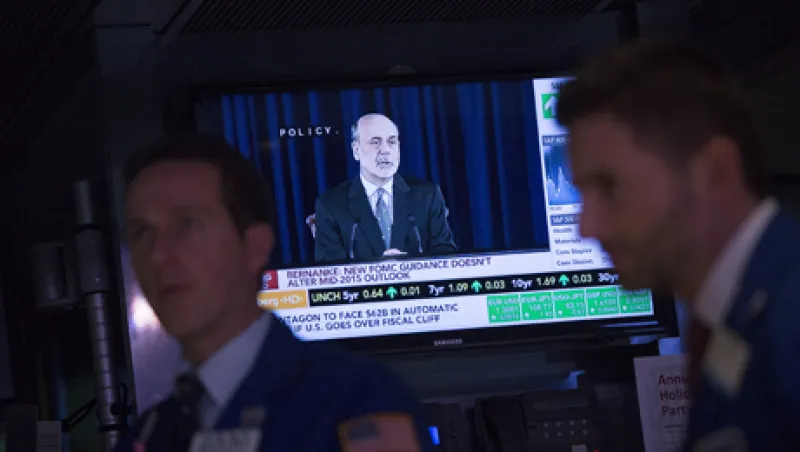The new year has arrived, but it remains to be seen if Santa Bernanke will bring a rise in interest rates to corporate pension plan sponsors hoping for a funding gift. Whether 2013 will be the year that the Federal Reserve finally lets rates rise is a burning question for plan sponsors; if and when this does occur, it may represent a bottom for pension funding levels, which fell to 75 percent in 2012 from 106 percent of pension obligations in 2007, according to Towers Watson.
Pension funding performance in this current recovery is decidedly subpar. Unlike the last recession of 2001–2002, when funding levels began to rise in 2003 and continued to rise through 2007, after the financial crisis of 2008, pension funding crashed to 77 percent, then rose in 2009 and 2010, hitting 84 percent. Funding levels then resumed their decline in 2011 and 2012 and are now below their levels at the height of the financial crisis.
A number of factors affected funding levels in 2012: contributions, investment gains and new benefit accruals. But the biggest factor of all was a decline of 55 basis points in the average yield on indexes of long-dated, high-grade corporate bonds used by actuaries to discount future obligations in pension plans, according to Mike Archer, senior consultant at Towers Watson in Parsippany, N.J. “That decline in interest rates increased the obligations for [corporate] pension plans by about $175 billion,” says Archer. “That was far and away the major driver behind the decline in the funding level.” Absent lower interest rates, funding levels would have risen and deficits would have fallen, according to Archer.
On January 3, however, a crack appeared in the Federal Open Market Committee’s (FOMC) near-unanimous agreement on the no-hikes direction of monetary policy. That’s when the Fed released minutes of its December 11–12 meeting, which revealed some possible future dissent against the Fed’s monthly purchase of $45 billion in Treasuries and $40 billion in mortgage-backed securities.
“Several others thought it would probably be appropriate to slow or to stop purchases well before the end of 2013,” the minutes stated, “citing concerns about financial stability or the size of the balance sheet, which has grown from $869 billion in 2007 to over $2 trillion.”
Previously only one person had spoken out publicly against the extent of the bond purchase program — Jeffrey Lacker, president of the Federal Reserve Bank of Richmond. None of the new members expressing doubts about the bond-buying program cast a vote against the current policy at the December meeting.
When the Fed minutes were made public on January 3, Treasury yields rose and prices fell. Reports that “several” members favored a slowing of or an end to quantitative easing before the end of the year sparked a lot of commentary.
“I think most people think rates will be back up, but the trillion-dollar question is when is that going to happen?” says Jonathan Barry, senior partner at Mercer in Boston. “Sponsors and economists and all sorts of interested parties have been saying that rates can’t get any lower for the past four years, and, lo and behold, they go lower,” Barry says.
The weak economy and the euro crisis in Europe, which has seen assets flow to the dollar as a safe haven, aren’t helping raise interest rates in the United States. The key driver, however, is the accommodative monetary policy by the Federal Reserve, whose efforts have helped steadily push down rates over the past four-plus years. The Fed has frequently reiterated its commitment to keep interest rates between zero and 25 percent and in December said the policy would last until unemployment falls to 6.5 percent.
The Fed’s policies, Archer says, argue against the likelihood of any increase any time soon in corporate-bond yields, which parallel the moves in Treasury rates. Yet even so, “interest rates will ultimately increase,” he says. “If they do not, that says some very bad things about the economy.”
For the Fed to reverse course, the economy would have to strengthen enough to push down unemployment, or increase inflation, to the FOMC’s targets.
During 2012 the deficit in corporate pension funding increased significantly — by $73 billion to $557 billion at the end of 2012, the highest year-end number ever, according to an estimate by Mercer. Towers Watson estimates the deficit rose by $79 billion to $418 billion.
Corporate plans were granted funding relief under the Moving Ahead for Progress in the 21st Century Act (MAP-21), which funded highway construction last July. The law gives plans a new choice for a discount rate. Sponsors can now choose between a 25-year average of rates allowable under MAP-21 and their most recent 24-month moving average, the only option allowed under the Pension Protection Act of 2006.
The funding relief was done, in part, to raise revenues for the federal budget, since lower overall contribution costs to plans can increase profits and thus taxes paid to the government.
Archer says it is too soon to know to what extent companies may have taken advantage of funding relief, pointing out that some companies, such as General Motors and Ford, have been very public about accelerating their contributions to close funding deficits.
According to Barry, if interest rates remain where they are, “then the funding status would improve largely through contributions to the plan — that’s going to be the driver. It’s going to be cash funding that closes the gap.”
Trying to peg when underfunding will hit bottom becomes somewhat of a guessing game because so many factors come into play. Returns could go lower, or contributions could turn out to be lower than expected for 2012, says Barry, perhaps because of the funding relief granted mid-year.
Even so, the direction of interest rates bears watching, he contends. “That is probably the most powerful lever affecting funding.”






